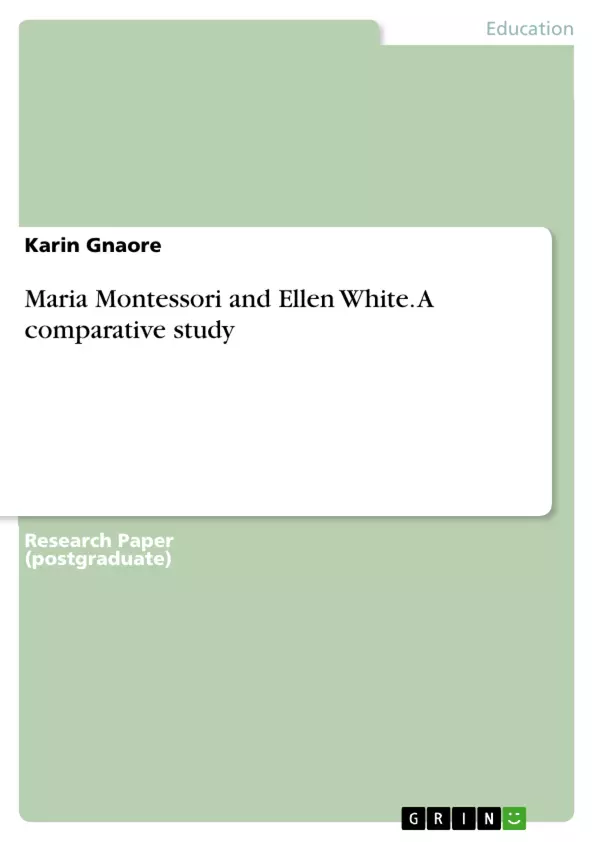This thesis compares the educational methods and writings of Ellen Gould White and Maria Montessori. It shows that there are a number of significant similarities in between both methods. The large number of resemblances suggests that Maria Montessori copied from Ellen White's works or at least read them. I could not find any evidence that she did although it is possible that she read some of Ellen White's writings, since her son married an American wife and Maria Montessori also visited the USA at least two times. Yet this remains a possibility which I was not able to prove.
I suggest that since both authors were interested in the very best education and development up to the highest standards possible for each and every child and both women were deeply religious and believed in the importance of religious education, teaching each child thankfulness to his creator and finding his or her purpose of life on this earth that it is this similar attitude towards children, God and life that lead both independently to the same results.
I compared the methods and “theories” of both educators with what modern science is teaching and found that neither Maria Montessori nor Ellen White can be contradicted in any way by what modern educational and psychological science research say.
Inhaltsverzeichnis (Table of Contents)
- What Makes an Educational Method Effective?
- Ellen White and Maria Montessori – two women educators of the 19th and early 20th century...
- The life of families Harmon and Montessori in 19th and early 20th century
- Life and work of Ellen Harmon White and Maria Montessori
- Travels of Ellen White and Maria Montessori
- Principles of education of White and Montessori
- On education
- Heredity and environment
- Child development and learning
- The role of the teacher
- Practical skills
- Cooperation
- Discipline
- Independence
- Nature
- Conclusion
- The Role of the Teacher
- Ellen White's Educational Advices and Methods
- How far have Ellen White's educational ideas been spread
- Ellen White's child guidance compared to modern education
- Introduction
- Ellen's encounter with religion
- Principles of religious education
- God in nature
- Parental influences
- Acquiring practical skills and labour
- Character development and discipline
- Duties of teachers
- Conclusion
Zielsetzung und Themenschwerpunkte (Objectives and Key Themes)
This thesis compares the educational methods and writings of Ellen Gould White and Maria Montessori. It aims to demonstrate that there are significant similarities between both methods. The objective is to determine if Maria Montessori drew inspiration from Ellen White's works or at least read them.
- Similarities and differences between the educational methods of Ellen White and Maria Montessori.
- The influence of religious beliefs on both educators' approaches to education.
- The alignment of both educators' methods with modern educational and psychological science.
- The historical context and impact of both educators' work on contemporary education.
- The relevance of their methods to contemporary educational practices.
Zusammenfassung der Kapitel (Chapter Summaries)
The first chapter introduces the two educators, Ellen White and Maria Montessori, providing brief biographical sketches and historical context. It explores their respective backgrounds and the societal influences that shaped their perspectives on education. The second chapter delves into the core principles of education as articulated by both White and Montessori. It examines their views on child development, learning processes, the role of the teacher, and the importance of practical skills, cooperation, discipline, independence, and nature in education. The third chapter focuses on Ellen White's specific educational advice and methods, exploring her ideas on religious education, the importance of parental influence, acquiring practical skills, character development, and discipline. It also examines the extent to which her educational ideas have been disseminated and their impact on contemporary education.
Schlüsselwörter (Keywords)
This thesis focuses on the comparative analysis of the educational methods of Ellen White and Maria Montessori, examining the similarities and differences between their approaches. Key themes include child development, learning processes, the role of the teacher, religious education, practical skills, cooperation, discipline, independence, and the alignment of their methods with modern educational and psychological science.
- Citation du texte
- PhD Karin Gnaore (Auteur), 2014, Maria Montessori and Ellen White. A comparative study, Munich, GRIN Verlag, https://www.grin.com/document/322732



